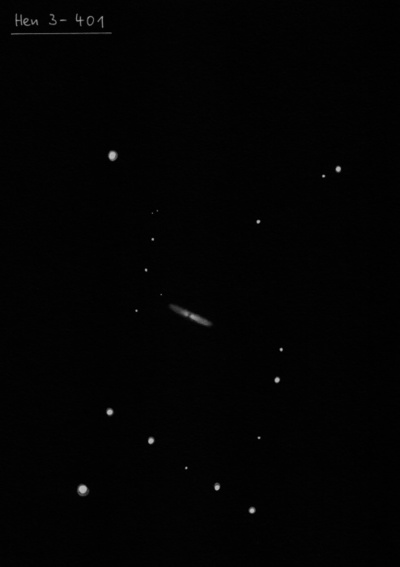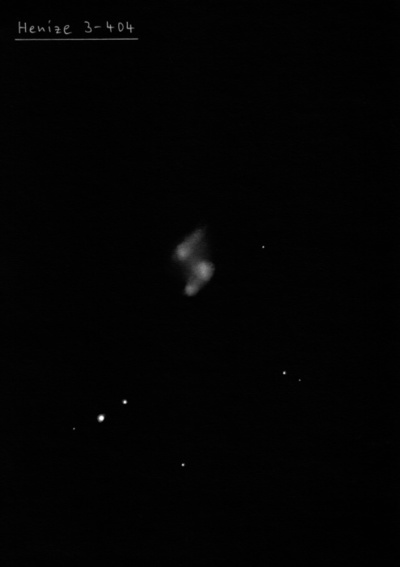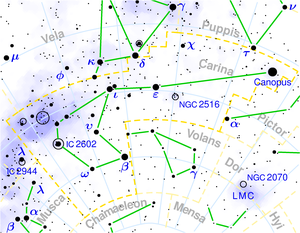 Carina is the dominant constellation in the southern sky, with the entire eastern part of the constellation delving into one of the richest regions of the Milky Way, with an extensive array of deep-sky objects. Six bright open clusters can be found here in binocular alone. Three of them are real showpieces: NGC 2516 and NGC 3532 are very bright, large and contain many stars. IC 2602 is a group of other bright stars popularly known as the Southern Pleiades. The second brightest star in the sky, Canopus, and the η Carinae Nebula, the brightest region of ionized hydrogen in the Milky Way, occupy an area of four degrees in the sky. In its interior lies a very interesting 6th magnitude star, also called η Carinae. It is a pity that the constellation of the Carina is practically impossible to observe from Europe.
Carina is the dominant constellation in the southern sky, with the entire eastern part of the constellation delving into one of the richest regions of the Milky Way, with an extensive array of deep-sky objects. Six bright open clusters can be found here in binocular alone. Three of them are real showpieces: NGC 2516 and NGC 3532 are very bright, large and contain many stars. IC 2602 is a group of other bright stars popularly known as the Southern Pleiades. The second brightest star in the sky, Canopus, and the η Carinae Nebula, the brightest region of ionized hydrogen in the Milky Way, occupy an area of four degrees in the sky. In its interior lies a very interesting 6th magnitude star, also called η Carinae. It is a pity that the constellation of the Carina is practically impossible to observe from Europe.
Of particular note here is the bright and sharply defined Milky Way cloud, which spills over into the neighbouring Crux. Of all the parts of the Milky Way, it appears the most colourful - white, with a very slight tendency to a bluish hue. It is important to note that at this point our view turns directly along the axis of Sagittarius' spiral arm. You can trace its northeastern part all the way to the constellation of the Scutum, where it bends again at the point of the Cloud in the Scutum. However, if you look more closely you will see that while the Cloud in the Scutum is only 25 degrees from the centre of the Galaxy, the star cloud in Carina is a good 75 degrees away. The explanation is simple. The arm of Sagittarius starts from the centre of the Galaxy in the direction of the constellation of the Scutum and stretches further south, while in Carina it is already far from it, encircling the centre and disappearing in the distance behind it. While objects in Sagittarius are on average five thousand light-years away, NGC 6231 in Scorpius is already 6,000 light-years away and NGC 4755 in the Southern Cross is 8,000 light-years away. Within the star cloud itself, there are a couple of diverse subdivisions that look like dark smudges in binoculars over a very rich star field surrounding several of the aforementioned clusters. A truly unique sight.
Canopus (α Car) - The main star of the constellation, but once also the entire Argo Navis, is α Argus, which represented the helm. As it is located on the very northwestern edge of the constellation, as an orange star it could be seen from as far as northern Africa low above the southern horizon. During the local winter, it culminates about 20 minutes before Sirius in Canis Major. Canopus is a yellow supergiant of spectral class FO, with its brightness of -0.8mag, it is the second brightest star in the sky after Sirius. It is 313 light-years away from the Sun and is 200,000 times more luminous than it. Interestingly, it is located far from the ecliptic, which is why most interplanetary satellites use it for spatial orientation.
R Carinae - The variable star of Mira Ceti type with a magnitude range from 3.9 to 10.5 and a period of 309 days.
η Carinae - An unusual variable star, massive and unstable, which may explode as a supernova in the future. In 1677, Edmund Halley observed that this star brightened to 4th magnitude. By 1730, it reached 2nd magnitude, in 1827 it brightened to 1st magnitude, and in April 1843, it temporarily became the second brightest star in the sky with a brightness of -0.8 magnitude! In the following years, its brightness decreased, and since 1868 it has sometimes been invisible without a telescope, as its brightness ranged around 6th stellar magnitude. However, in the infrared region, it remains the brightest source in the sky.
Falešný kríž - The quartet of stars ι, ε Car, and δ and κ Velorum form the letter X in the sky, which is often confused with the stars of the Southern Cross. However, the False Cross is slightly larger, more symmetrical, and less bright. ε Car is a beautiful double star distinguishable in a smaller telescope. It consists of two components with brightness of 3mag and 6mag, separated by 5".
NGC 3372
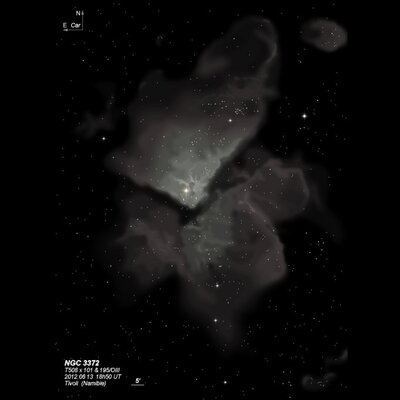
The brightest section forms a triangular wedge isolated by prominent dark lane that cuts at a striking right angle. This wedge contains the centerpiece Eta Carina which has an amazing orange color. Extending from Eta are the two small lobes (one is brighter), referred to as the "Homunculus nebula" and appearing as an explosive event from the early 19th century in a HST image. Just preceding Eta is an elongated N-S, curving dark lane nicknamed the "Keyhole Nebula" by John Herschel, as well as the open cluster Tr 16 just south of Eta.
Nicolas-Louis de Lacaille discovered (telescopically) NGC 3372 = Lac III-6 = D 309 = h3295 in 1751-1752 with a 1/2-inch telescope at 8x during his expedition to the Cape of Good Hope. He recorded a "Large group of a great number of small stars, little compressed, and filling out the space of a kind of a semi-circle of 15 to 20 minutes in diameter; with a slight nebulosity spreading in that space." Of course, the nebula and embedded clusters is a prominent naked-eye object, so was certainly known by southern sky watchers.
James Dunlop observed it at least 13 times and recorded "(Eta Roboris Caroli, Bode) is a bright star of the 3rd magnitude, surrounded by a multitude of small stars, and pretty strong nebulosity; very similar in its nature to that in Orion, but not so bright... I can count twelve or fourteen extremely minute stars surrounding Eta in the space of about 1'; several of them appear close to the disk: there is a pretty bright small star about the 10th magnitude N.f. the Eta, and distant about 1'. The nebulosity is pretty strongly marked; that on the south side is very unequal in brightness, and the different portions of the nebulosity are completely detached, as represented in the figure [plate III, figure 14]. There is much nebulosity in this place, and very much extensive nebulosity throughout the Robur Caroli, which is also very rich in small stars."
John Herschel commented "It is not easy for language to convey a full impression of the beauty and sublimity of the spectacle which this nebula offers, as it enters the field of the telescope fixed in R. A., by the diurnal motion, ushered in as it is by so glorious and innumerable a procession of stars, to which it forms a sort of climax, and in a part of the heavens otherwise full of interest."
During a 5-year period in the 1840's and '50s Eta Car brightened from 1.5 to -1 (chronicled by John Herschel) and was temporarily the second brightest star in the sky, nearly rivaling Sirius. This outburst later created the double-lobed Homunculus Nebula, discovered in 1944. According to Wolfgang Steinicke, in 1863, Francis Abbott, an amateur in Tasmania, claimed a decrease in the size and brightness of the main nebula and displacement relative to Eta Car using a 4-inch refractor, but a number of critical replies followed by Lt. John Herschel (son of JH), Airy and Lassell. Interestingly, the dark "Keyhole Nebula" does appear to have lost contrast based on JH's sketches and descriptions.
As far as the origin of the nickname "Keyhole Nebula" it's generally assumed that JH coined the phrase and his sketch of the elongated dark patch near Eta certainly appears like a perfect classic "keyhole". But a search through his Cape Observations and articles about the brightening of Eta Car and possible variability of the nebula reveals he used the term "lemniscate" to describe the shape (must have been his early mathematical training).
In an 1873 issue of Appletons' Journal, Emma Converse, who reported on astronomical topics for the popular press, summarizes the dispute about changes in the nebula in an article titled "Eta Argus". She mentions "In the middle of the brightest part of the nebulous light there was a dark vacancy, of a form resembling a keyhole, or the geometrical figure called a lemniscate, around which the light of the nebula was not uniform." Later she mentions "The southern loop of Herschel's lemniscate, or keyhole-shaped cavity had bulged out into the vacuity, forming an isthmus that trended north-south." Agnes Mary Clerke refers to the "Key-Hole Nebula" in her "The System of the Stars" (second edition, 1905), plate XVII taken with the Bruce 24-inch at Arequipa in 1896.
300/350mm - 12" (6/29/02 - Bargo, Australia): My first views of the Eta Carina nebula through Les Dalrymple's 12.5" and Gary's 20" were truly breathtaking and dwarfed the Orion Nebula in size and detail. The nebula is broken into 4 or 5 main separate masses of varying sizes, shapes and surface brightness by three wide, dark obscuring dust lanes. The mottled nebulosity has an amazing 3-dimensional curdled appearance and is riddled with dark bays and rifts. Outer loops and brighter streaks complete an amazing vista.
400/500mm - 20" (7/8/02 - Magellan Observatory, Australia): Using a 20 Nagler (127x) and UHC filter, the field of Eta Carina was a breathtaking sight. The outer wings and streamers extended well outside the 39' field. The turbulent nebulosity had a curdled, electric appearance with a strong 3-dimensional effect as brighter streaks, wings, fainter masses and dark lanes were mixed together throughout the field.
The best overall view of the nebula in the 20" was at 80x (32 mm) using a UHC filter. Even at this low power, the Eta Carina nebula still overfilled the field with contrasty dark lanes and amazingly structured islands of nebulosity. I stared into the eyepiece quietly, somewhat stunned by its beauty. With this aperture at 282x, the 12"x8" bipolar Homunculus nebula was an astounding sight. The orange central star appeared quasi-stellar with the unequal blowouts fairly prominent. They had an eerie, translucent appearance with the western lobe somewhat smaller, fainter and more pinched with the eastern lobe more circular. A possible dark lane is near the center and punctures the lobes.
Tr 14 is a rich group of stars mag 7 and fainter stars in a 5' region, situated ~12' NW of Eta within one of the sections of nebulosity. Contains the binary h4356 (7.2/8.9 at 2.8"). The brighter spectroscopic member of the mag 7.2 star (HD 93129Aa) is one of the most massive stars known and rivals Eta Car in mass and luminosity. A triple system h4360 just 2' SE includes a 2" pair. Cr 232 is a small, scattered group of ~20 stars in a 4' region just following Tr 14. The brightest star is mag 7.7 HD 93250, a 04-type supergiant. Tr 16, the most massive cluster in the Carina complex, is a triangular group of stars just south of Eta and includes a chain of a half-dozen brighter stars. Tr 15 is a fairly small group of a couple dozen stars mag 8.5 and fainter, less than 30' N of Eta Car. A half-dozen members are O-type supergiants.
Cr 228 is a large, scattered cluster ~25' SSW of Eta Carina in the southern part of the complex. It includes two mag 6.5 stars with brightest member 6.2-6.5 QZ Carinae and the Wolf-Rayet star HD 93131. Includes a number of mag 8-9 stars spread over a 15'x10' field. The group is elongated SW-NE.
Bochum 10 is a group of two dozen stars in a ~5'x2' region. It includes 7 mag 9 stars that dominate the group. Fairly scattered and distributed in the two subgroups NW and SE with the SE group containing most of the stars. Located just 5' NW of mag 5.4 HD 92964 and just south of the southern arc of the HD 92809 Wolf-Rayet ring. Situated just north of the huge wedge that extends north of Eta, ~40' NW of the star. Visually the cluster appears much smaller than the listed diameter of 20'.
At 282x, the 12"x8" bipolar Homunculus nebula surrounding Eta Carina was an astounding sight. The orange central star appeared quasi-stellar with the unequal blowouts fairly prominent. They had an eerie, translucent appearance with the NW lobe somewhat smaller, fainter and more pinched with the SE lobe more circular. A possible dark lane is near the center and punctures the lobes.
600/800mm - 24" (4/11/08 - Magellan Observatory, Australia): this observation of the Homunculus was made at 350x in good seeing with the 24". Eta Carinae appeared an iridescent electric-orange color surrounded by the bipolar blowouts of the Homunculus. The brighter and larger lobe, which is expanding in our direction, extends to the southeast and was pretty circular (a bit flattened on the end), but punctured by a small, elongated hole that splits the lobe near Eta, creating a small 6" loop (connected on the SE end). The NW blowout is fainter and smaller with an unusual "fountain" or "fan" appearance (also referred to as the "paddle" in schematics of the Homunculus), tapering in and dimming to an extremely narrow bridge at Eta and then spreading out to the NW. The NW edge of this lobe is rounder, creating a "fan" appearance. The two lobes create empty notches near Eta and extending into the NE notch between the two lobes is a very thin, short spike (referred to as equatorial debris or "skirt) that was not difficult to view but the SW "spike" was only intermittently visible. Just west of Eta is the fairly prominent, dark "Keyhole Nebula".
Notes by Steve Gottlieb
IC 2602
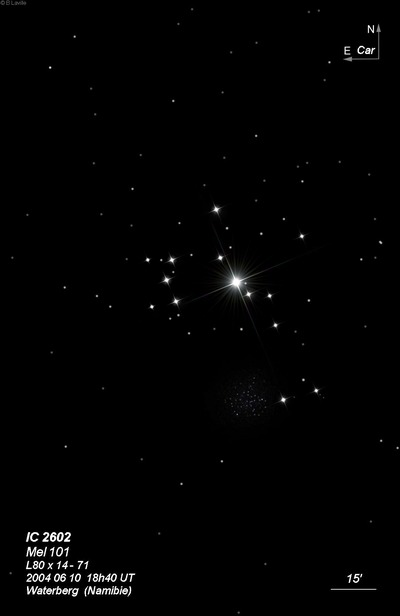
Nicolas-Louis de Lacaille discovered IC 2602 = Lac II-9 in 1751-1752 with a 1/2-inch telescope at 8x during his expedition to the Cape of Good Hope. He recorded "The star Theta Navis, of the third magnitude or less, surrounded by a large number of stars of 6th, 7th & 8th magnitude, which resemble the Pleiades." The nickname "Southern Pleiades derives from this description. Solon Bailey also found the cluster on a photographic plate in 1896 using a 1" (f/13) Cook lens at the Arequipa station. The discovery was reported in "A Catalogue of Bright Clusters and Nebulae" (Annals of Harvard College Observatory, Vol LX, No. VIII) and Bailey was credited with the discovery in the IC.
300/350mm - 14.5" (4/4/16 - Coonabarabran, 73x and 147x): beautiful, very large cluster, centered 12' E of a mag 5.5 star. Roughly 120-150 stars are resolved, depending on the assumed size. There is no distinct boundary so the size is pretty arbitrary but most of the brighter stars are within a 8'-10' circle. Many of the stars are arranged in long chains and loops. The brightest mag 9.7 star is at the west end, but the majority of the stars are 12-13 magnitude.
Notes by Steve Gottlieb
NGC 3532
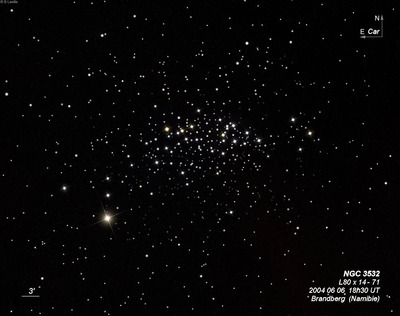
10x30mm Canon IS (3/28/19 - Tasmania): absolutely stunning cluster - very prominent naked-eye, rivals nearby Eta Carina though smaller. A couple of dozen stars were resolved in 10x30mm binoculars including a few very bright stars. Some additional faint stars scintillated in and out of view.
Nicolas-Louis de Lacaille discovered NGC 3532 = Lac II-10 = D 323 = h3315 in 1751-1752 with a 1/2-inch telescope at 8x during his expedition to the Cape of Good Hope. He described a "prodigious number of faint stars forming a semi-circle of 20 to 25 minutes diameter."
James Dunlop observed the cluster 3 times (including first night of logging on 27 Apr 1826) and described "a very large cluster of stars about the 9th magnitude, with a red star of the 7-8th magnitude, north following the centre of the cluster. Elliptical figure: the stars are pretty regularly scattered."
John Herschel was very impressed with the cluster, including it in a list of 'greatest hits': "Among the nebulae which occur from 9h to 12h we have .. the beautiful planetary nebula [NGC 2867], a perfect planet in appearance, with an attendant satellite; the falcated nebula [NGC 3199]; Eta Argus with its nebula; the superb cluster [NGC 3532]; the blue [Herschel's italics] planetary nebula [NGC 3918], a most exquisite and unique object ; and the beautiful cluster of various coloured stars about Kappa Crucis [NGC 4755]."
His first sweep on 31 Mar 1834 reported "Chief star of a very large, round, loosely scattered cluster of stars 8..12th magnitude, which fills 2 or 3 fields. A fine bright object." His next observation recorded "The chief star of a superb cluster, which has several elegant double stars, and many orange-coloured ones." On 5 Feb 1835 (sweep 543, the night described in his diary as "most superb" and "having attained the sublime of Astronomy - a sort of ne plus ultra") he wrote,"A glorious cluster of immense magnitude, being at least 2 fields in extent every way. The stars are 8, 9, 10 and 11 mag, but chiefly 10th magnitude, of which there must be at least 200. It is the most brilliant object of the kind I have ever seen."
300/350mm - 13.1" (2/18/04 - Costa Rica): this amazing naked-eye cluster packs several hundred stars, filling the 20mm Nagler field (74x and 65' field of view) with wall-to-wall stars in a 55'x35' region! The central region is condensed and quite rich with several dense knots consisting of pairs, triples, chains, etc. The brighter stars are extended ~E-W and includes 6th magnitude K2-type star (HD 96544). There is no well-defined edge to this immense cluster although a huge "U" shaped chain of stars extends around the periphery. A neat equal-mag equilateral triangle of stars stood out within the central maze of stars.
The cluster is quite prominent naked-eye as a 45' cloud just 3° ENE of Eta Carina in the NE corner of the rich Carina starcloud and was densely packed with dozens of resolved stars in the 9x50mm finder. Mag 3.9 V382 Carinae (a Delta Cepheid variable not considered a cluster member) is just off the SE side.
400/500mm - 18" (7/7/02 - Magellan Observatory, Australia): This spectacular naked-eye and binocular cluster (3° ENE of Eta Carina) filled the entire 51' field of the 27mm Panoptic (76x) with several hundred stars mag 7 and fainter resolved. The cluster is unusually elongated ~E-W, perhaps 55'x30' and widening on the following side. The stars are irregularly distributed with many in pairs, small groups, chains and loops. A group of about a dozen stars forms a perfect "S" asterism. Interestingly, there is a lack of dense knots although the entire central region is rich. Many of the stars appear to have a blue or yellowish tint. This is one of the very top open clusters in the sky although it is probably best in a wider field view.
Notes by Steve Gottlieb
NGC 2516
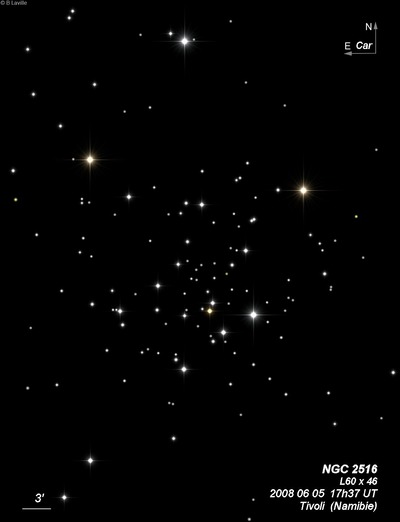
10x30 Canon IS (7/10/02 - Magellan Observatory, Australia): this is a prominent naked-eye cluster below the "False Cross" (formed by Epsilon and Iota Car as well as Delta and Kappa Vel), on a line with the longer axis (Epsilon Car and Kappa Vel) of the cross. In binoculars, it appeared well-resolved, ~50' diameter including outliers with 5 bright stars (mag 6.5-7.5) with a couple of dozen stars resolved overall. Appears fairly rich towards the center with a number of mag 8-10 stars.
10x30mm Canon IS (3/28/19 - Tasmania): very bright naked-eye cluster, gorgeous even at 10x with a couple of dozen stars resolved, 40'-50' diameter, many brighter stars around the periphery, but richer towards the center.
Nicolas-Louis de Lacaille discovered NGC 2516 = Lac II-3 = h3111 in 1751-1752 using a 1/2-inch telescope at 8x during his expedition to the Cape of Good Hope. He noted a "Group of 10 to 12 stars, very compressed." NGC 2516 was not published in Dunlop's main catalogue but his handwritted notes read "Very fine cluster about 35' diameter, many of the stars of the 6th and 7th magnitude, mixed magnitudes. Figure irregular branched."
JH observed the cluster a number of times with his 18-inch f/13 speculum telescope at the CGH. His first record reads: "An orange-coloured star 8th magnitude, in middle of a large and magnificent cluster of perhaps 200 to 250 stars 8..16th mag. Many of the larger magnitudes, and really a superb object. Very visible to the naked eye, etc."
300/350mm - 13.1" (1/30/06 - Costa Rica): very bright naked-eye cluster located 3° SW of Epsilon Car (southern star in the False Cross). Appears partially resolved in the 9x50 finder and an excellent view using the 15x50 IS binoculars. The cluster fills over half of the 20mm Nagler field, ~30'-35' diameter with over 100 stars resolved. The outline is quite irregular though well-detached at low power. A mag 5.2 M-type giant orange star (V460 = HD 66342) lies at the NE edge of the cluster. The central region is more concentrated and uniform and includes a number of tinted yellow or orange stars. A nice triple star (h4027 = 7.1/7.8/9.3 at 9" and 20") is on the west edge of the cluster and an excellent double (h4031 = 7.2/8.0 at 5") lies on the east side of the cluster. A long curving string starts in the center and heads NE to the mag 5.2 orange star. This string includes a 9" evenly matched pair of mag 9 stars (Innes 1104) that was resolved at low power. Mag 5.7 K-type orange subgiant HD 65662 is off the NW side of the cluster.
13.1" (2/17/04 - Costa Rica): this bright naked-eye cluster is located SW of the "False Cross" (3 degrees SW of 2nd-magnitude Epsilon Carinae) and is the only open cluster in western Carina. It was well resolved in the 9x50 finder. At 105x, the main group is 25'-30' with outliers increasing the size and roughly 100 stars are resolved including a number of mag 6-8 stars. Many of the stars are arranged in loops and strings and overall the cluster is quite irregular in magnitudes and star distributions. There is a close, fairly bright double on the SE side (7.2/8.0 at 5.5") and a neat 13' chain of stars near the west side running N-S.
Notes by Steve Gottlieb
NGC 3114
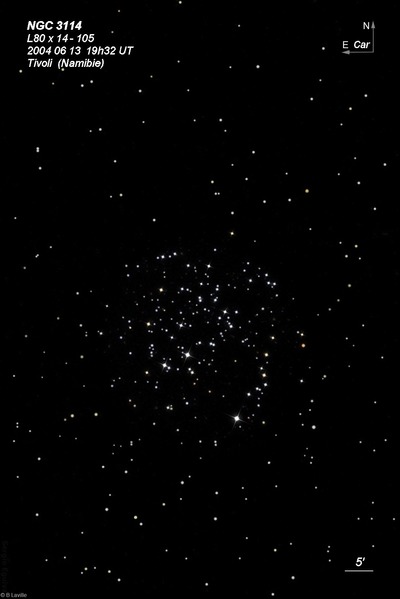
James Dunlop discovered NGC 3114 = D 297 = h3224 on 8 May 1826 with his 9-inch f/12 reflector from Parramatta near Sydney. He described "a beautiful cluster of stars, arranged in curvilinear lines intersecting each other, about 40' diameter, extended S.p., and N.f." This is the brightest object Dunlop discovered and his position is within the cluster, though ~10' NW of center. It's surprising that Lacaille didn't catalogue this bright cluster during his trip to the Cape of Good Hope.
On 4 Feb 1835 (sweep 543), John Herschel noted "an enormous congeries or clustering region of stars 2 or 3 fields in diameter, constituting a decided cluster. Stars 9..14th mag, the larger magnitudes predominating. There must be many hundreds." In his diary, JH noted "the night being most superb - the mirror billiant and the zone swept the richest perhaps in the heavens - attained the sublime of Astronomy - a sort of ne plus ultra".
400/500mm - 18" (7/8/02 - Magellan Observatory, Australia): this very bright naked-eye cluster measures some 35'-40' in diameter and is framed beautifully in a 50' field with the 27mm Panoptic. The cluster contains a couple of long curving chains of brighter stars, one forming a huge "U" shaped arc. There are several pretty smaller groupings and star chains including a striking equilateral triangle of nearly equal mag stars just north of center, consisting of mag 9.2/9.4/10 stars at 20"/22"/27". Two mag 6-7 stars (brightest mag 6.2 HD 87436) are involved and in addition there are numerous 8-9th magnitude stars scattered across the face of the cluster. Appears similar to a bright star cloud in Sagittarius or Cygnus and the cluster is just inferior to NGC 3532. Located 5° west of Eta Carina on the opposite side of Eta from NGC 3532. This is a young cluster (160 million years old) projected onto the Carina complex and the cluster is heavily contaminated by field stars at varying distances.
Naked-eye - and 10x30mm Canon IS (3/28/19 - Tasmania): very bright naked-eye cluster only 5° W of Eta Carinae. At least 3 dozen stars were resolved at only 10x in the 30mm binoculars!
Notes by Steve Gottlieb
NGC 3293
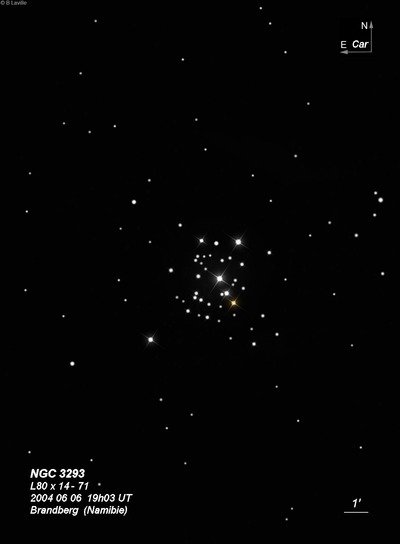
Nicolas-Louis de Lacaille discovered NGC 3293 = Lac II-8 = D 321 = h3276 in early 1752, using a 1/2-inch telescope at 8x during his expedition to the Cape of Good Hope. He described a "Small heap of 4 small stars forming a lozenge."
James Dunlop claimed to observe the cluster 4 times (first on 29 Apr 1826) and described "a very small cluster of very small bright stars; round figure, about 4' diameter; rich in extremely small stars resembling faint nebula". His position is poor -- 17' WSW of the cluster.
John Herschel only has a rough position in the Cape catalogue using his small refractor (no published observations with his 18-inch!) and he noted "a fine, bright, rich, not very L cluster. (Equatorial zone review)." A corrected RA was given in the IC 2 notes (Harv. Ann., xxvi, p207). Neither Lacaille nor Dunlop are listed as discoverers in the Cape catalogue, GC or NGC.
Henry Chamberlain Russell coined the nickname the "Gem Cluster" in an 1879 paper.
300/350mm - 12" (6/29/02 - Bargo, Australia): this very rich, young cluster is situated just NW of the Eta Carina complex and is one of the top open clusters in the southern sky. It is bright, compact and very rich with a half-dozen mag 6-8 stars over a rich background of dozens of mag 10-13 star in a 10' diameter. Appears somewhat similar to the Jewel Box including a mag 7 reddish supergiant, but with even a more compact appearance. The listed 40' diameter is much larger than the visual impression.
Notes by Steve Gottlieb
NGC 2808
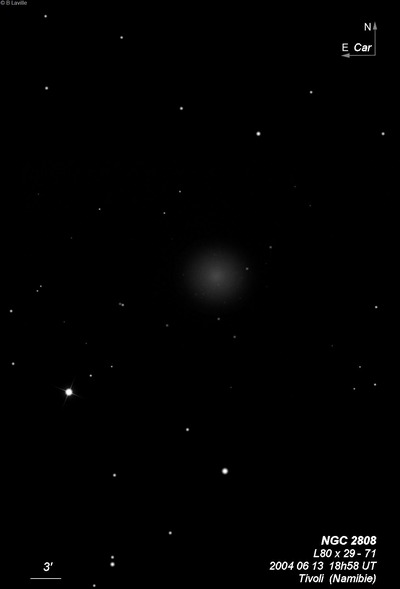
James Dunlop discovered NGC 2808 = D265 = h3152on 7 May 1826 and recorded "a very bright round nebula, about 3' or 4' diameter, very gradually bright to the centre. This has a fine globular appearance." His position is 20' too far northwest, but the identity is certain.
John Herschel recorded 4 detailed observations from the Cape of Good Hope: On the first sweep (8 Mar 1834) he logged it as a "globular cluster, extremely compressed pretty gradually very much brighter to the middle; up to a perfect blaze; diam. in RA = 26.8 seconds; stars of 16th magnitude." His final observation (9 Feb 1837) notes "a truly beautiful and delicate globular cluster; diameter in RA = 45 seconds, that of the most compressed part 15 seconds; gradually very bright in the middle; all finely resolved into perfectly equal stars like the finest dust, which are seen with the left eye without effort, but the right requires to be somewhat strained to discern them. Runs up to a blaze in the centre."
300/350mm - 13.1" (2/20/04 - Costa Rica): this very bright globular was large and elongated, ~8'x6' SW-NE increasing to 2' bright core and a blazing 40" nucleus. At 144x, this cluster was mottled but with no obvious resolution. At 166x a large number of extremely faint stars (mag 14-15) popped in and out of view over the entire disc, though the resolved stars could not be held steadily. Located 1.8° NNE of mag 4.0 Alpha Volantis.
10x30mm Canon IS (3/28/19 - Tasmania): fairly bright but fairly small at 10x. Contains a very bright small core. I wasn't confident of a naked-eye sighting.
400/500mm - 18" (7/8/02 - Magellan Observatory, Australia): at 171x, this bright globular (ranked 10th brightest at V = 6.1) is fairly large, ~10' diameter and very compressed with a blazing 2' core. The halo is noticeably elongated, nearly 3:2. A dense swarm of mag 14 and fainter stars were resolved in the halo and around the edges of the core but the inner central core was unresolved. At 228x, there appeared to be some very faint stars lanes streaming into the halo, which were barely unresolved but looked like small tentacles. A mag 10/10.6 double at 16" is outside the cluster ~10' ESE. This is by far the brightest concentration class I globular and the only one easily resolved.
600/800mm - 24" (4/11/08 - Magellan Observatory, Australia): at 200x, this was a stunning showpiece globular in the 24"! The central region displayed an unusually strong concentration with a super-intense 2' core that was unresolved. A very bright, small halo surrounded the core, which was mottled but mostly unresolved. The outer halo resolved into perhaps 150-200 mag 14.5 and fainter stars. The halo gradually thinned out in resolved stars out to 10' diameter. The core was smaller but still unresolved at 350x. The overall appearance of the three brightness levels mentioned above is unusually symmetrical.
Naked-eye - (7/8/02 - Magellan Observatory, Australia): faintly visible naked-eye.
Notes by Steve Gottlieb
NGC 3199
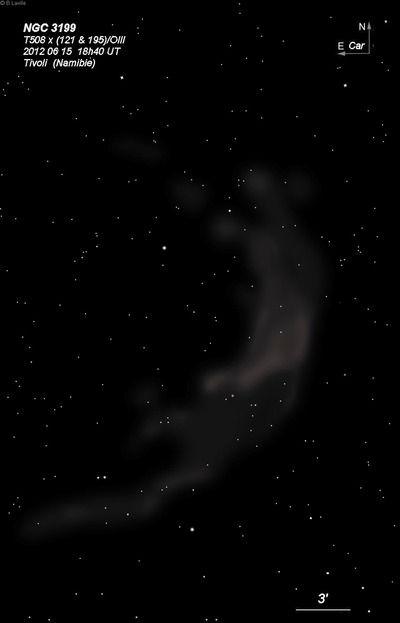
9x50mm finder (2/17/04 - Costa Rica): surprisingly, NGC 3199 was visible in the 50mm finder at just 9x by blinking with the OIII filter. An elongated bar of nebulosity was seen!
James Dunlop discovered NGC 3199 = D 332 = h3239 on 1 May 1826 and described a "very faint ray of nebula, about 2' broad, and 6' or 7' long, joining two small stars at the south following extremity, which are very slightly involved, but their lustre is not diminished from that of similar small stars in the field. The north extremity also joins a group of small stars, but they are not involved. Figure 15 [very basic sketch]." Unfortunately Dunlop made a one degree error in reading or copying the declination so he didn't receive credit in the GC or NGC (Glen Cozens recovered the identity of D 332).
John Herschel rediscovered this Wolf-Rayet nebula on 1 Apr 1834, unaware of Dunlop's earlier observation. He recorded, "A very large and very remarkable nebula, which is brighter to the S.f. part, and dies off to the N.p., having a curved form and forked tail. In the head of it is a double star. The nebula is pretty bright, very large, figure irregular, 8' long, 4' broad. Among a vast number of milky way stars." On 5 Feb 1835 (sweep 543, the night described in his diary as "most superb" and "having attained the sublime of Astronomy - a sort of ne plus ultra") he wrote, "very bright, very large, 10' long, of a concave or crescent form, sharply terminated inwards, fading away outwards. In a field of about 80 stars. The place is that of a 13th mag star, about the middle of the crescent, or rather nearer the head." His sketch from that night is reproduced on plate IV, figure 3. Later that month (sweep 552) he wrote: "pretty bright, very gradually brighter in the middle, of a falcated or semilunar shape, extending over three-quarters of the field. The place is that of a double star in its vertex or southern extremity."
Joseph Turner sketched NGC 3199 carefully on 28 Apr 1876 using the Great Melbourne Telescope (unpublished lighograph plate VII, figure 67). The SE end is tapered and brightest and the wide northwest end is forked with the eastern fork slightly brighter. A lithograph was completed but not published. Albert Le Sueur had earlier made a similar sketch with the 48", as well as Pietro Baracchi on 16 Jan 1885.
300/350mm - 13.1" (2/17/04 - Costa Rica): at 105x and UHC filter, this HII region appears as a remarkable, huge crescent, roughly 11'x7' (the main region extends nearly 1/3 of the 39' field). Opens up towards the east in a huge "C" shape. The SW portion of the crescent is brightest, although the overall surface brightness is irregular with a mottled or curdled appearance. A few stars are superimposed even with the filter with the brightest stars at the SW end. Fainter nebulosity sprouts out of the SW end, increasing the total size by several arcminutes.
400/500mm - 18" (7/8/02 - Magellan Observatory, Australia): this is an amazing HII region with a 20mm Nagler and UHC filter at 103x. It appears as a fairly bright, thick crescent opening towards the east, roughly 10'x6'! The surface brightness was quite irregular with a UHC filter and the nebulosity was noticeably brighter on the south end where a couple of brighter stars are embedded. Off the bright portion of the south end, much lower surface brightness haze extends the curve further SE for several arcmin and spreads out somewhat increasing the length to ~15'. The main mass has a curdled, mottled appearance and dark lanes appear to intrude into the nebulosity. The illuminating star HD 89358 is a Wolf-Rayet star (WR 18) and this nebulosity is reminiscent of the Crescent Nebula in Cygnus (it could be dubbed the "Southern Crescent").
600/800mm - 24" (4/11/08 - Magellan Observatory, Australia): at 200x and UHC filter this Wolf-Rayet bubble appeared as an amazing 180° crescent, open on the east side and forming a thick "C" shape. The rim of the bubble is widest on the western portion, although it is slightly brighter on the southwest side. The main portion of the crescent spans ~13' from the north to south end and appears ~3.5' thick in the middle, though fainter nebulosity spreads out to the southeast. A double star (h4302 = 10.4/11.6 at 23") is embedded near the south end. The surface brightness is fairly high overall, though irregular with slightly brighter patches, knots and streaks. A faint 5' linear streak or filament running NNW-SSE is superimposed along the outer western edge, though it separates or resolves from the Crescent at its north and south ends. The illuminating mag 10.6 Wolf-Rayet star (WR 18 = HD 89358) is located about 4' E of the center of the "C", and is asymetrically positioned with respect to the center of the entire shell. This W-R bubble is situated four degrees NW of the Eta Carina nebula in a rich Milky Way star field.
Notes by Steve Gottlieb
NGC 3324
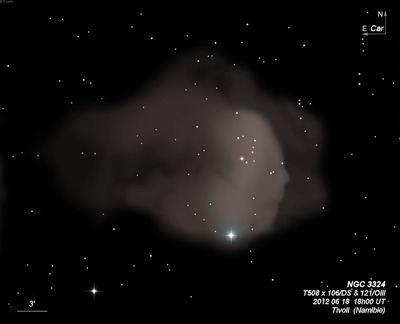
James Dunlop discovered NGC 3324 = D 322 = h3286 on 1 May 1826 and described a "star of the 7th magnitude, involved in faint nebula." His position was roughly 6' NW of center of the nebula.
John Herschel credited Dunlop with the discovery and reported on 1 Apr 1834 "A double star involved in nebula, which is one of the outliers of the great nebula about Eta Argus. It extends to a star 6.7 mag half a field distant southwards, and almost as far north; pretty bright; irregular figure; fine object."
IC 2599, found by Williamina Fleming on a Harvard College Observatory plate in May 1893, refers to the southern portion of this nebula.
300/350mm - 13.1" (2/18/04 - Costa Rica): striking HII region and cluster 30' SE of NGC 3293 and 90' NW of the center of the Eta Carina nebula! (this is an outlying piece of the Eta Carina complex) At 105x and UHC filter this huge, elongated, irregular nebula is quite bright, perhaps 15'x6' in size and tapers towards the south end where mag 5.5 HD 92207 is embedded. The nebula widens to a well-defined bulbous mass on the north end. Faint nebulosity hooks off the north end and spreads to the east and northeast. This HII region is ionized by mag 8 HD 92206 = h4338 (an 8.2/9.2 pair at 5") situated near the center of the nebula. Unfiltered, a scattered group of stars is superimposed but this just appears to be a random star grouping in the Carina section of the Milky Way.
600/800mm - 24" (4/11/08 - Magellan Observatory, Australia): I only took a quick look at the "Gabriela Mistral" Nebula at 200x and a UHC filter, but the brightest portion appeared like a cartoon drawing of a whale with a huge, very bright bulbous "head" forming the northern end of the nebula. The brightest portion is perhaps 15'x6' in size, but quite an extensive amount of fainter nebulosity spreads out the east and southeast of the main body, significantly increasing the size to ~15'x11', elongated N-S. Some faint nebulosity also spreads to the west of the main portion. At the south end is the mag 5.5 star HD 92207.
Notes by Steve Gottlieb
NGC 2867
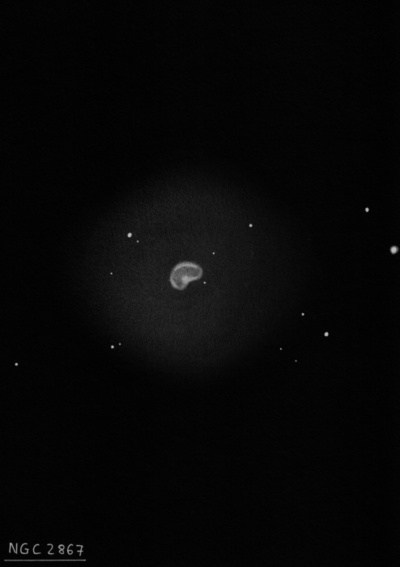
John Herschel discovered NGC 2867 = h3163 on 1 Apr 1834 (sweep 435) and called it "The finest planetary nebula I ever remember to have seen for sharpness of termination; 3" diameter; exactly R; no more haziness about them than would be about a star of the same magnitude to-night (which is a favourable one) Light, a pale white = * of 9th +/- mag. Position of companion star = 58.6° (mean) ; * = 15th mag. A very remarkable object. Showed to [assistant] Stone, who distinctly perceived the total difference of appearance between it and a star 9th mag very near it. A second companion * suspected (at about half the distance of the 1st by diagram, and at an estimated position of 330°) among multitude of large and small stars." The next night he observed it again with Thomas Maclear, astronomer at the Royal Observatory, while it was out of the meridian, to check if it might be a planet. But he noted it had "not moved perceptibly, and is therefore not a planet."
Joseph Turner, observing with the 48-inch Melbourne Telescope on 26 Feb 1878, noted the color was a pale bluish, instead of the "pale white" noted by Herschel.
400/500mm - 18" (7/8/02 - Magellan Observatory, Australia): at 171x (unfiltered) this striking planetary is bright (V = 9.7), small, very high surface brightness oval with a pale blue color. With a UHC filter, it appeared ~15"x10" and appeared like a cosmic easter egg set in a beautiful star field! Located 1.1° NE of mag 2.3 Iota Carinae (southeast star of the "False Cross").
600/800mm - 24" (4/10/08 - Magellan Observatory, Australia): beautiful, very high surface brightness blue planetary at 200x, set in a rich star field. Stunning view at 520x. The thick, oval rim is clearly brighter with a relatively small darker hole in the center! I didn't notice this structure in the 18" several years back from Australia.
Notes by Steve Gottlieb
IC 2553
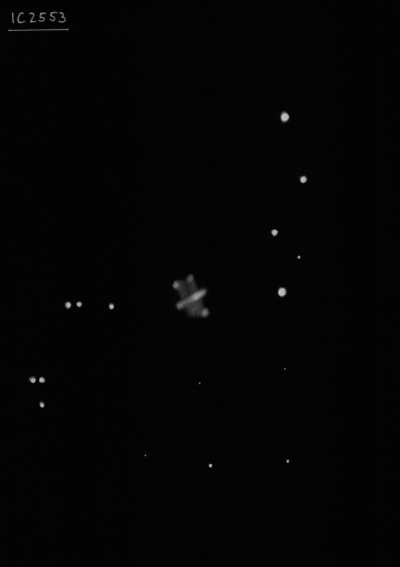
Williamina Fleming discovered IC 2553 = Fleming 70 in 1893 on a Harvard objective prism plate taken at the Arequipa station.
400/500mm - 18" (7/8/02 - Magellan Observatory, Australia): at 171x this small, high surface brightness planetary was immediately seen in a rich star field. It appeared bright (V = 10.4), very small, slightly elongated, ~8"x6", with a bluish tinge. Excellent contrast gain with a UHC filter. Located 58' directly west of NGC 3211 which was viewed immediately afterwards.
Notes by Steve Gottlieb
NGC 3211
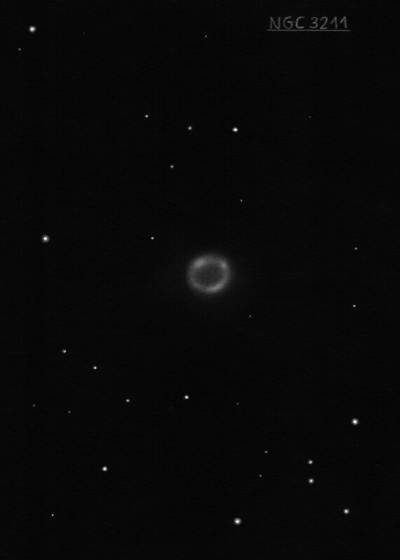
John Herschel discovered NGC 3211 = h3242 on 7 Mar 1837 and recorded "planetary nebula, delicate, exactly round, = * 10 mag, a little dim at edges; white; with 320x considerably hazy. In field with at least 150 stars." The next sweep he recorded "perfectly round; very well defined, with a perfectly uniform light, not at all mottled; = a star 10th mag, of which brightness there are 5 or 6 more in the field, and not less than 150 others less bright. Examined by both Mr Maclear and myself with 240x which shows it proportionally magnified; quite round and planetary; a little hazy at the edges, but not more so than is due to the decidedly bad definition of the night, and the imperfect figure of the mirror, which has been injured by careless polishing on too soft a polisher."
300/350mm - 13.1" (2/18/04 - Costa Rica): Picked up unfiltered at 105x as a moderately bright, 15" disc. Good contrast gain with UHC filter. Appears bright, evenly illuminated with a well-defined bluish halo. Appears to float in a beautifully rich Carina star field and centered within a parallelogram of mag 10.5 stars (sides ~9'x7'). Located 1.3° south of the mag 3.4 q Velorum.
400/500mm - 18" (7/8/02 - Magellan Observatory, Australia): at 171x and UHC filter this fine planetary appeared as a very bright, round disc, ~15" diameter, crisp-edged with a bluish hue. Good filter response to UHC. The surface brightness was very high and there was a hint of a slightly brighter rim. Set in a rich Carina star field.
Notes by Steve Gottlieb
NGC 3576
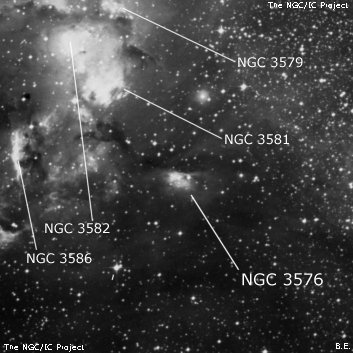
NGC 3576 is a somewhat isolated patch on the southwest side, about 5' from the main sections. At 128x and a UHC filter it appeared as a faint, circular hazy patch of low surface brightness with a mag 12.5 star at the west side and ~1.5' in diameter. NGC 3579 is a small, fan or wedge-shaped section located just to the west of larger NGC 3584. It appears 2' in size with a 12th magnitude star at the south tip and spreads to the north and west from this star. NGC 3581 is the brightest section of this complex and has sharply defined borders running SW-NE and NW-SE, meeting at a right angle about 1' WNW of mag 9.2 SAO 251313. The overall size is ~2'x1.5' with an irregular surface brightness. It is just disconnected from NGC 3582, which is close NE. NGC 3582 is another fan-shaped section which wraps around a mag 10.6 star. It has a well-defined edge running SW to NE with the northern border running E-W. The brighter star is embedded roughly in the center and several mag 13 stars are near the border. The diameter is ~2' (similar in size to NGC 3581 just SW). NGC 3584 is the furthest NE and the largest section of nebulosity. It appears as a looping arc about 3.5'x1', bowed out towards the east and extending mostly N-S and narrowing at the north end. A few mag 12 stars are off the edges. NGC 3579 appears as nearly a continuation of this loop towards the west. Finally, NGC 3586, the last in the complex, is situated ~4' SE of the center of the group of nebulae. It appears as a faint, elongated steak of 2' length oriented N-S with an 11th magnitude star about 40" NE of the north tip. The entire group was roughly sketched and easily matched up with the DSS later. NGC 3603 lies ~25' E.
John Herschel discovered NGC 3576 = h3324 on 16 Mar 1834 and recorded "F, oval. The first of a group of 6. Place by collation of diagrams." His (rough) position is too far southwest. His sketch was included in the CGH Observations, plate IV, figure 10.
Joseph Turner also sketched this group of nebulae on 19 May 1876 using the Great Melbourne Telescope (plate IV, figure 35 at www.docdb.net/history/texts/1885osngmt________e/lithograph_m_4_35.php). He sketched it noticeably elongated E-W.
400/500mm - 18" (7/7/02 - Magellan Observatory, Australia): NGC 3576 is the first of six sections in a small, but very interesting nebulous complex consisting of NGC 3576, NGC 3579, NGC 3581, NGC 3582, NGC 3584 and NGC 3586 – all situated in the same low power field with NGC 3603! The entire group is often referred to as the NGC 3576 nebular complex or the RCW 57A region.
Notes by Steve Gottlieb
IC 2581
Edward Pickering (or assistant) discovered IC 2581 on a Harvard plate taken at the Arequipa station on 10 May 1893.
300/350mm - 14" (4/4/16 - Coonabarabran, 73x and 145x): very bright group of stars, dominated by mag 4.7 supergiant V399 Car. This yellow star forms the eastern vertex of an equilateral triangle with a mag 7.1 star 4.3' NW and a mag 8.7 star 4' SW. In a 5' region there are roughly 35 stars, including a few mag 10-11 just south of the mag 4.7 star. A curving star chain with fainter stars extends north of V399 Car. The NGC 3247 cluster/nebula lies 27' SW.
Notes by Steve Gottlieb
NGC 3572
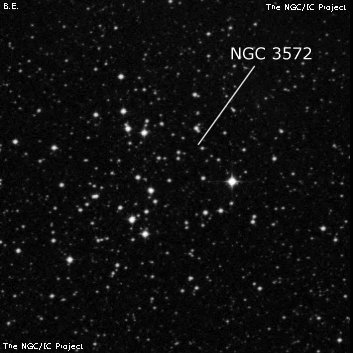
John Herschel discovered NGC 3572 = h3323 on 14 Mar 1834 and noted "Middle of a tolerably rich cluster, class VIII." His position is good.
400/500mm - 18" (7/7/02 - Magellan Observatory, Australia): at 228x, this is an 8' irregular group of 80-100 stars including a mag 7.9 star on the west side and about a dozen mag 10 stars. A mag 6.7 star lies 11' SE of center outside of the apparent cluster (but part of Cr 240). A dark patch abuts the cluster and there is an impression of more bright and dark nebulosity in the field. At 128x with the UHC filter, the cluster is adjacent to a large field of faint nebulosity to the north (RCW 54) with the borders of the nebulosity seemingly obscured by dust. Located 16' NW of mag 4.6 HD 97534.
Notes by Steve Gottlieb
NGC 3247
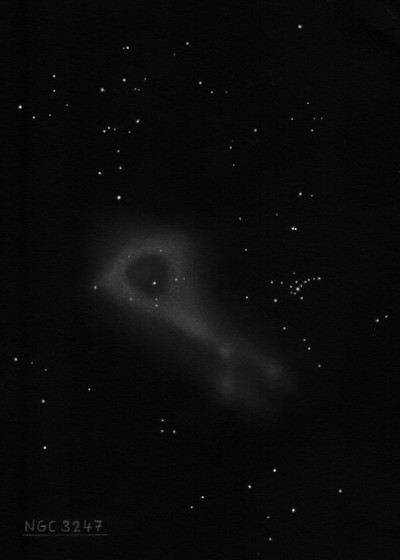
At 145x, fairly faint emission haze was easily visible in an irregular 2.5' region just to the east of Westerlund 2. A mag 12 star is embedded near the center of the nebula, a mag 11.5 star is just off the north edge and a few additional stars are involved. Adding a NPB filter, RCW 49 is a fairly bright, irregular nebula! The brightest part (centered on the star) was roughly circular with a well-defined northern boundary, but it spread further south and southwest to a ~4'x3' region.
Cr 220 (often misidentified as NGC 3247) is located ~15' SE of the NGC 3247 complex in the same low power field. Roughly three dozen stars were resolved at 145x in a 6' circle, with the central part slightly condensed. The brightest mag 9.8 star is at the north end with a mag 12 companion [13" separation]. A small quadrilateral of mag 13-13.5 stars [sides 14", 14", 18", 17"] is on the southwest side. No involved nebulosity was seen.
John Herschel discovered NGC 3247 = h3250 on 1 Apr 1834 and described "a curious object. Stars involved in evident nebula." The next sweep he logged, "there is a nebulous appearance, which merits re-examination. Observed much past meridian, and no reliance on the PD [polar distance]." A third observation only has a very approximate polar distance. His rough (mean) position is 10 24.8 -57 51 (2000). Joseph Turner unsuccessfully searched for this object using the 48" Melbourne Telescope on 12 Feb 1879, as well as Pietro Baracchi on three different occasions, perhaps due to Herschel's poor position.
Using a Harvard plate, DeLisle Stewart identified NGC 3247 at 10 23 58 -57 48.5 (2000), and Dreyer repeated this position in the IC 2 notes. Brian Skiff places NGC 3247 more accurately at 10 24 01 -57 45.6, corresponding with ESO 127-SC18 = Westerlund 2. This compact cluster (~1.5' dia) is embedded in the HII region RCW 49 = Gum 29, which spreads out ~10' in size. ESO and Lynga misidentify Cr 220 as NGC 3247. This group of stars is 1.0 tmin following and 5' south of JH's position.
300/350mm - 14" (4/4/16 - Coonabarabran, 145x and 230x): NGC 3247 consists of a compact cluster (often referred to as Westerlund 2), one of the most massive young star clusters known in the Milky Way, and a large, irregular H II region (RCW 49) with star-forming pillars similar to the Eagle Nebula. At 230x, the cluster extended ~1.5', but the richest part was a dense, elongated clump only 45" long with a half-dozen tightly packed mag 13.5-14 stars resolved in an WNW-ESE string. Off the SW side is mag 13.5 WR 20a, one of the most massive binary systems (both superluminous O3-type stars). The cluster is situated 12' N of mag 5.8 HD 90289.
Notes by Steve Gottlieb
NGC 3519
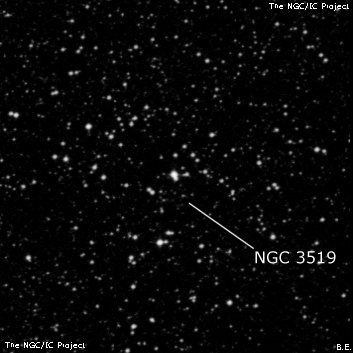
John Herschel discovered NGC 3519 = h3314 on 14 Mar 1834 and reported, "Chief star of a pretty rich cluster, class VII." His position match the unequal double star HJ 4400 within a small cluster.
According to Brian Skiff, Ru 93 appears to be a string of stars on the northeast side of the cluster or may simply be a duplicate of NGC 3519. In a visual observation with a C-8, Jenni Kay observed about two dozen stars in a single cluster of 5' diameter with two brighter stars at the southwest edge. RNGC classifies the number as nonexistent, though the group was confirmed as a star cluster by Bica and Bonatto in 2011A&A...530A..32B ("Star clusters or asterisms? 2MASS CMD and structural analyses of 15 challenging targets.")
300/350mm - 14" (4/5/16 - Coonabarabran, 145x and 178x): roughly 80 stars resolved in an irregular 6' region (boundary pretty arbitrary), many of these arranged in chains or curving streamers of stars. On the west side is the brightest mag 9.7 star (mag 12.5 companion at 8" = HJ 4400) with a linear chain of mag 13 stars just west (oriented SW-NE). Another chain of mag 12-13 stars (oriented NW-SE) is on the northeast side. A mag 7.4 star (HD 96193) is roughly 8' SSE and a long chain of stars heads north from this bright star, reaching the south side of the cluster.
Notes by Steve Gottlieb
NGC 3496
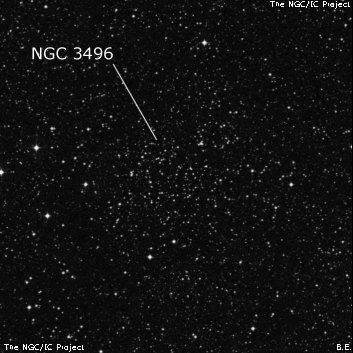
Sher 1, a very small cluster, is 13' NE of NGC 3496. Using an 18" f/4.5 at 182x it appeared as a small 1' knot of ~10 stars including a few bright mag 9.5-11 stars, but several are very faint.
John Herschel discovered NGC 3496 = h3310 on 14 Mar 1834 and recorded the "Place of a small double star in the following part of a loose, rich, pretty large cluster of stars 13m. 8 or 10' in diameter; a fine object; a very much condensed milky way group." His position is on h4395, a mag 12 pair at 9".
300/350mm - 14" (4/2/16 - Coonabarabran, 160x): this cluster is situated in a glorious Milky Way field! The cluster is beautifully rich with mag 12 and fainter stars, roughly 60-75 stars in a 5'-6' circular region (this is the richest section) and 100-125 stars within a 9' region elongated E-W. On the east side is HJ 4395 = 11.5/12.0 pair at 9" and a small knot of stars is on the northwest side. A mag 9.3 star is off the east side and a mag 9.2 star is off the south side. Located 34' ENE of 6th magnitude T Carinae and 80' WNW of NGC 3572.
Notes by Steve Gottlieb
NGC 3590
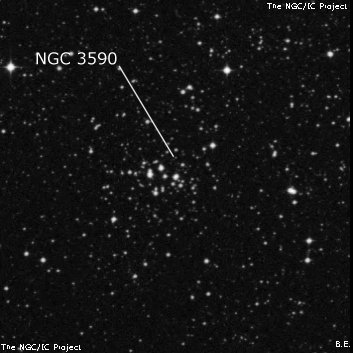
John Herschel discovered NGC 3590 = h3332 on 4 Feb 1835 (sweep 543) and recorded "a close, p rich, compressed, oval cluster, somewhat insulated." His position is good.
400/500mm - 18" (7/7/02 - Magellan Observatory, Australia): at 228x, this is a small, fairly bright 2' knot of ~20 stars mag 10 and fainter. At 76x this diminutive cluster is set in a remarkable field, forming a triangle with NGC 3603 and the NGC 3579-86 complex (RCW 57) to the south.
Notes by Steve Gottlieb
IC 2714
James Dunlop discovered IC 2714 = D 281 on 27 Apr 1826 (first night he recorded objects) with his 9-inch reflector at Parramatta, NSW. He described a "cluster of very small stars, a little elongated preceding and following, about 10' diameter; the stars are congregated towards the centre, a pretty bright star south, and a double star south following this." His position was ~7' too far north, within his usual erros.
Solon Bailey independently discovered the cluster in 1896 on a photographic plate using a 1-inch f/13 Cook lens at the Arequipa station. The discovery was reported in "A Catalogue of Bright Clusters and Nebulae" (Annals of Harvard College Observatory, Vol LX, No. VIII) and Bailey was credited with the discovery in the IC. His description reads "cluster, pretty compressed." In 1927, Harry Wood reported that based on a Franklin-Adams plate, the cluster doesn't agree in appearance with Bailey's description. "This cluster is an open large cluster (12' in diameter) and is the same magnitude and is of the () Carinae type. It lies immediately north of CPD -62 1953." In the same note he described nearby cluster Cr 246.
600/800mm - 24" (4/11/08 - Magellan Observatory, Australia): this was a surprisingly appealing cluster, roughly 13' in diameter and framed nicely in the 30' field at 200x in the 13mm Ethos. The stars are fairly uniform in brightness with a large number of mag 11-12.5 stars and they give the impression of being connected in numerous loops and chains over the entire cluster. The cluster is not concentrated, though there are several mag 11 stars near the center and a close double. Mel 105 is located 48' SSE.
Notes by Steve Gottlieb
NGC 3603
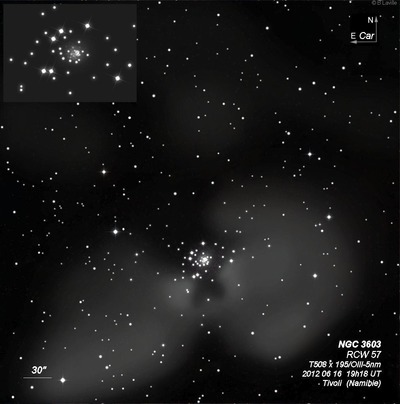
John Herschel discovered NGC 3603 = h3334 on 14 Mar 1834 NGC 3603 and recorded "a red star 10m, the centre of an excessively condensed group of stars 15...18m, with a nebulosity extending over 2' diameter. On the next sweep, he noted "the center, when examined with powers 240 and 320, decidedly not a star, and the nebula about it all resolved. Perhaps it is a globular clusters, vs vvmbM."
In 1928, Willem van den Bos examined the central "star" with the 26.5-inch refractor at the Union Observatory in Johannesburg and found "the central star to be a close double, B 1184, with many faint stars near." He measured the AB pair as 0.6" separation in PA 98°, with the "C" component at 1.8" in PA 75° and the D component (I 1132) at 2.7" in PA 259°. He also noted "The central double is red or at least decidedly reddish, though the spectral type is given as Oe in the Draper Catalogues..."
300/350mm - 13.1" (2/20/04 - Costa Rica): at 105x a bright irregular nebula surrounds a mag 9 "star". At 200x, a half-dozen very faint stars are packed very close to the central star. This very compact knot is actually a distant, very dense, super star cluster (SSC) of extremely luminous stars! Adding a UHC filter, the nebulosity is irregular at 105x, extending mostly south of the star and fading out into two or three sections that are possibly divided by a dark lane. The brightest section is to the southwest of the central star.
400/500mm - 18" (7/7/02 - Magellan Observatory, Australia): at 228x this distant but superluminous HII region is a fascinating clump of stars of and nebulosity surrounding a bright 9th magnitude knot. The bright central region was extremely dense and contained 10-12 stars crammed into 2', yet it seemed only partially resolved at the very center into a couple of stars. At 128x and UHC filter, the surrounding "haze" is clearly gaseous in nature with the brightest portion offset to the SW side from the core with a roughly broad fan with a total size of approximately 5'x3'. A dark lane appears to cut through the nebulosity towards the core and there is a strong impression that the field is riddled with dust lanes and patches. This is a well-studied highly reddened, luminous cluster (~20,000 light years) and HII region with similarities to the Tarantula nebula in the LMC!
600/800mm - 24" (4/5/08 - Magellan Observatory, Australia): this distant (20,000 light years) superluminous HII region and cluster was mesmerizing at 200x using a UHC filter. The nebulosity was generally elongated E-W, ~5'x3', but with bays and extensions and dark lanes. The surface brightness was highest to the south of the embedded cluster with a dark lane slashing through the nebulosity just west of the bright core. At 350x, 15-20 stars were resolved in the glow, though the tiny, brilliant "core" cluster (HD 97950) was only mottled and barely resolved into a few stars.
Notes by Steve Gottlieb
IC 2448
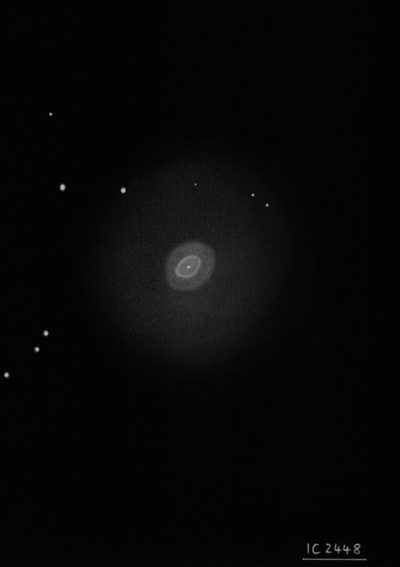
Williamina Fleming discovered IC 2448 = Fleming 80 on a Harvard objective prism plate taken in 1898 at the Arequipa station.
600/800mm - 24" (4/4/08 - Magellan Observatory, Australia): this extremely bright, 10.5-magnitude compact planetary is located 34' SW of mag 1.7 Beta Carinae (Miaplacidus). At 350x it appeared ~10" diameter with a very high surface brightness disc and a faint, thin outer envelope increasing the diameter a couple of arc seconds.
Notes by Steve Gottlieb
IC 2501
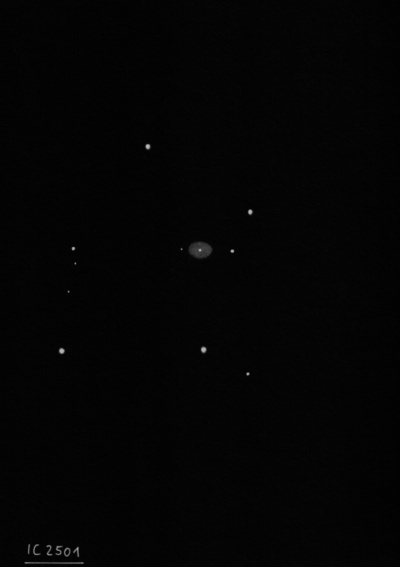
Williamina Fleming discovered IC 2501 = HN 101 in 1904 on a Harvard objective prism plate taken at the Arequipa station.
600/800mm - 24" (4/11/08 - Magellan Observatory, Australia): at 200x, this very compact planetary appeared as a very bright, mag 10.5 blue "star" that was slightly out of focus. Although it was barely non-stellar at this power, it was obvious by its "soft" nature and blue color that it was a planetary. Good contrast gain with a UHC filter. At 350x, IC 2501 was clearly resolved as a very small 3" disc with a crisp edge and extremely high surface brightness. Located 15' SE of mag 6.9 HD 83614.
Notes by Steve Gottlieb
IC 2621
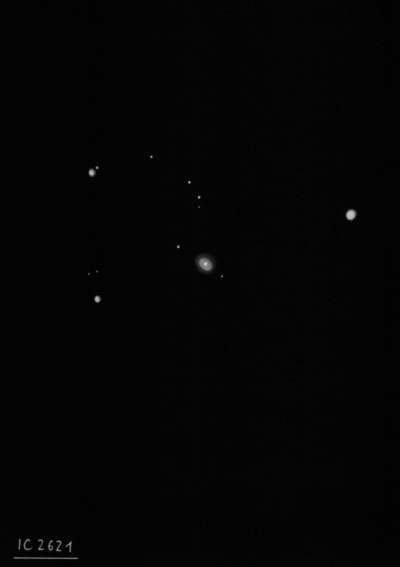
Joseph Lunt discovered IC 2621 = HN 106 visually in 1901 with the Cape Observatory 24-inch refractor fitted with an object-glass prism. He noted "a stellar nebula found visually with the 24-inch o.g. prism. Mag 10-11." Williamina Fleming independently discovered it in 1907 on a Harvard objective prism plate taken at the Arequipa station.
400/500mm - 18" (7/10/05 - Magellan Observatory, Australia): picked up by blinking with an OIII filter at 76x (27 Panoptic) and appeared as a slightly fuzzy bluish "star". Excellent contrast gain using the filter. Situated in the middle of a string of 3 stars with a mag 11.5 star 1' NW and a mag 10.8 star 75" SE. Appears ~0.5 magnitudes fainter than the SE star (giving an estimated V mag of 11.3) but significantly brighter using the OIII filter. Appears quasi-stellar at 228x, perhaps 3" diameter at most. Located 2° SE of IC 2502 = "Southern Pleiades".
Notes by Steve Gottlieb
NGC 3582
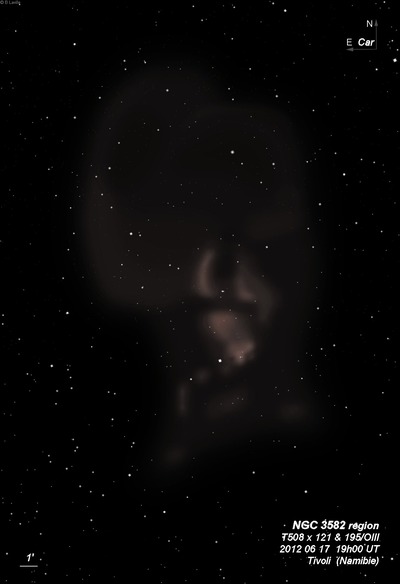
John Herschel discovered NGC 3582 = h3327 on 14 Mar 1834 in a complex of emission nebulae. He noted "R; has a * in middle. Place by collation of diagrams." Joseph Turner sketched the complex of nebulae in 1876 with the 48" Great Melbourne Telescope (plate IV.35 at www.docdb.net/history/texts/1885osngmt________e/lithograph_m_4_35.php).
400/500mm - 18" (7/7/02 - Magellan Observatory, Australia): NGC 3582 is another fan-shaped section which wraps around a mag 10.6 star. It has a well-defined edge running SW to NE with the northern border running E-W. The brighter star is embedded roughly in the center and several mag 13 stars are near the border. The diameter is ~2' (similar in size to NGC 3581 just SW).
Notes by Steve Gottlieb
IC 2220
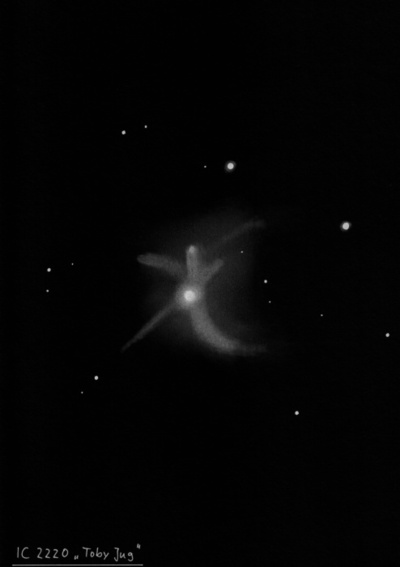
DeLisle Stewart discovered IC 2220 = DS 315 on a plate taken in 1908 at Harvard's Arequipa Station. He noted "!! Nebula involving [HD 65750], extends 2' in dec and 1' in RA, 2 B and 2 F spiral wisps, spiral in form."
IC 2220 was named the Toby Jug Nebula by Paul Murdin, David Allen and David Malin in their book "Catalogue of the Universe" published in 1979. David Malin included the Toby Jug Nebula in his 1999 book "The Invisible Universe" and wrote, "A few degrees from the bright star Avoir and a little south of Miaplacidus is a curious nebula with the uninspiring catalog name IC 2220. It has a popular name taken from its superficial resemblance to the profile of a toby jug, a traditional English beer mug with a large handle, with one side molded as a stout character with a rustic, painted face. My colleagues and I suggested the name Toby Jug in our book "Catalogue of the Universe" in 1978, and it seems to have stuck, even in the United States, where toby jugs are rarely seen."
300/350mm - 13.1" (1/30/06 - Costa Rica): at 105x the "Toby Jug Nebula" is visible surrounding a bright red variable star, V341 Carinae and was easy to chase down just 1.6° north of the naked-eye open cluster NGC 2516. The nebula appears as a large, irregular glow unfiltered. With careful viewing the west side is bowed in with thin extensions to the west on the north and south ends. The nebulosity is not as extensive on the following side of the star.
13.1" (2/17/04 - Costa Rica): The "Toby Jug Nebula" is an unusual bipolar red reflection nebula 1.5 degrees north of NGC 2516. Unfiltered at 105x, a fairly large irregular glow is visible surrounding the bright red M-class variable V341 Car = HD 65750 (mag 6.2-7.1). The nebula is bowed towards the west with the curved section on the following side of V341. It extends furthest to the NW and the SW and is indented and weaker due west of the star. The total size of the "Toby Jug" is 2'-3'.
Notes by Steve Gottlieb
IC 2554A
DeLisle Stewart discovered IC 2554 = DS 334 on a plate taken 20 Mar 1901 at Harvard's Arequipa station. He noted "cF, S,2-branch spiral, cE at 10°, N."
600/800mm - 24" (4/4/08 - Magellan Observatory, Australia): IC 2554 is a remarkable interacting multiple system or a single merger remnant with a tidal tail. At 260x it consists of what appeared to be a contact pair of edge-ons with just slightly different orientations (both ~SSW-NNE) that run into each other. The southern portion was brighter and larger, ~1.4'x0.3', while the northern component was perhaps half as long, though they appeared nearly merged so it was difficult to clearly distinguish. With averted vision, the appearance was even more confusing as there was a strong impression of an additional component or feature in the chain. NGC 3136B lies 8.3' ENE. IC 2554 is located 27' NE of NGC 3136.
Notes by Steve Gottlieb
